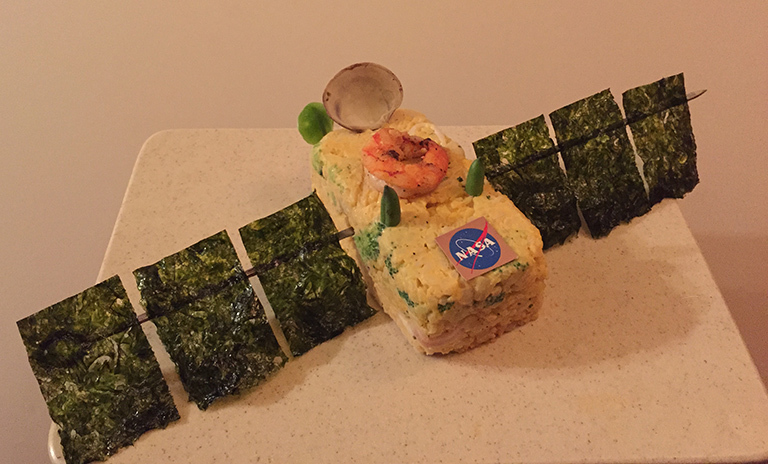Ask NASA Climate | January 6, 2016, 05:49 PST
A taste of the sea with Jason-3
Launching and lunching into space

Sustainable seafood model of the Jason-3 satellite.
The time has come, once again, to prepare for that thing we at NASA are best known for: launching satellites into space. And to commemorate this awesome occasion, I created, once again, an edible model.
This time, though, is a bit different. This time it’s Jason-3, and I kind of have a soft spot for it. See, Jason-3 is an oceanography satellite, and to me, the ocean will always be the most important thing in the world. Scheduled to launch January 17 at 10:42 a.m. PST, Jason-3 follows its predecessors, TOPEX/Poseidon (1992), Jason-1 (2001) and Jason-2 (2008, the first launch I ever saw), to continue measuring global ocean surface topography – or variations in sea level.
Gathering highly accurate sea-level measurements allows us to understand both global and regional changes in sea level rise, ocean circulation patterns and, of course, El Niño. (Yup, look outside. It’s raining its butt off, just like NASA scientists predicted it would, based on Jason-2 data.)
Also, by having a long, uninterrupted time series of data, we get the opportunity to better understand the long-term implications of ocean-warming due to climate change.
As usual, I made this model out of food I actually eat. The spacecraft bus is made of seafood risotto: rice, stock, butter, cream, clams, calamari, scallops, broccoli and saffron. The altimeter, which measures sea level, wave heights and wind speed, is tiger shrimp. The microwave radiometer, which measures water vapor and helps ensure instrument accuracy, is a clam shell. The GPS, which tells us the satellite’s exact position, is bell pepper. The DORIS instrument and the Laser Retroreflector Array, which also provide satellite location info, are green beans. The solar array is nori seaweed.
Because I care so much about our ocean, and because much of the seafood around the world is unsustainably caught, I always use the Monterey Bay Aquarium Seafood Watch app when selecting seafood. The app gives recommendations for choosing seafood that’s fished or farmed in ways that have less environmental impact.
BTW, yes, I ate the model. It paired quite nicely with a buttery Chardonnay.
Thanks for reading,
Laura
TOPEX/Poseidon and Jason-1 were cooperative missions between NASA and the French space agency, CNES. Additional partners in the Jason-2 mission included NOAA and Eumetsat. Jason-3 continues the international cooperation, with NOAA and Eumetsat leading the efforts, along with partners NASA and CNES.
